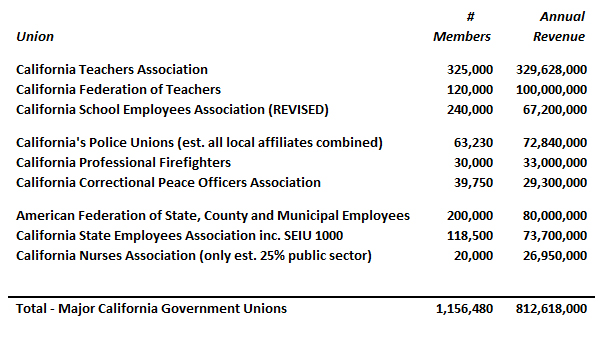Can Public Sector Union Power Ever Be Stopped?
Imagine you’re hoping to support a candidate for local office who will enact reforms that will improve your city, maybe even save it. Someone who will fight tirelessly to eliminate work rules that force agencies to hire more people than are actually necessary. Someone who will insist that incompetent public employees are fired. Someone who will finally do something about compensation and benefit packages that are threatening to bankrupt the city.
What do you say to them, when their response to your suggested reforms is this: “That’s all great, and I’d like to do it all, but who’s going to give me the million dollars for my campaign that I’m not going to get from the public employee unions if I actually try to do any of it?”
That is the sort of conversation that takes place, or would take place if anyone bothered to ask, multiplied by thousands, every election cycle in California.
Public employee unions run California. They exercise nearly absolute power in the state legislature, and in nearly every city, county, school district and special district. Can public sector union power ever be stopped?
Earlier this year, a California Public Policy Center analysis estimated that for 2016, total membership in California’s public sector unions was 1.15 million, and total revenue was $812 million. This equates to a stupefying $1.6 billion that these unions collect and spend every election cycle.
California’s Public Sector Unions (including local affiliates)
Estimated Total Membership and Revenues

While the figure of $1.6 billion per election cycle is a credible estimate, attempts to come up with precise information on California’s public sector union dues is nearly impossible. In California there are many hundreds, if not thousands, of individual local public sector union affiliates. All of them file separate 990 forms, often including financial transfers between entities that have to be offset in any thorough analysis.
Determining how much of California’s public sector union revenue is spent on politics is also a nearly impossible task, despite several online “transparency” portals, including OpenSecrets, FollowTheMoney, VoteSmart, and the California Secretary of State’s Campaign Finance “Power Search.” These portals are primarily focused on national races, and in some cases, statewide races, but none of them descend to the thousands of California’s local races, where hundreds of millions of dollars are spent every election.
Moreover, the portals can only display the information they’re given. California’s government unions, like most sophisticated political players, mask their total spending through multiple committees and transfers.
An excellent analysis of how much of teachers union dues end up being spent on political campaigns was written in 2015 by RiShawn Biddle, editor and publisher of Dropout Nation – a leading commentary website on education reform. He writes: “The pro bono consultants who went through the unions’ published national, state, and local tax returns estimated based on their research, interviews, and sampling that roughly one third of the unions’ efforts went toward political advocacy.”
One-third. In California, that is equal to approximately $540 million per election cycle. That is, California’s public sector unions likely spend over a half-billion per election cycle. And this spending does not include other “non-political” spending. For example, not reportable as political spending can include massive public education campaigns that are designed to influence voters but aren’t engaging in explicit advocacy.
Also not considered political spending, but having immense political impact, is litigation. There are countless examples of how government union power is exercised in California’s courts. Pension reforms in San Jose and San Diego, approved by voters, were eviscerated through relentless court challenges. Statewide pension reform pushed by Gov. Brown and partially realized in the PEPRA legislation of 2012 was undermined, and continues to be undermined, beneath an ongoing avalanche of lawsuits. Charter schools are the targets of continuous litigation designed to wear them out. You can do this, when you have hundreds of millions of dollars pouring in every quarter, year after year.
California’s political landscape over the past 20-30 years has been defined by public sector unions. While the recent Janus v AFSCME decision by the U.S. Supreme Court has taken away the ability of government unions to compel payment of fees, the unions are resorting to clever contractual gyrations to make it extremely difficult in practice for anyone to stop paying. That too, will have to sort itself out in court, where union money guarantees tenacious defense and endless appeals.
Even if public employees can easily withdraw from paying government unions, in many cases, why would they? These unions have made California’s public employees some of the highest paid public servants on earth. A California Policy Center study in 2017 concluded “The composite average total compensation (pay and benefits) for a full-time city, county or state worker in California during 2015 was $121,843; for the average full-time private sector worker in California, including benefits, it was 62,475, which is 51% of what the public sector worker earned.” As a result, it is no coincidence that California’s state and local governments confront over $1.0 trillion in debt and unfunded pension liabilities.
The political and financial power of public sector unions has transformed California politics. Their influence is felt everywhere; education, environmental policy, the business climate, important cultural issues. In every area, their primary agenda is to grow their membership and influence. The effect of this agenda is pernicious. If schools fail, spend more public money on schools. If crime increases, hire more police and build more prisons. Wherever society fails, grow unionized government.
Perhaps the next major U.S. Supreme Court case concerning government unions will abolish them due to this inherent conflict between their agenda and the public interest. Perhaps someday they will be outlawed entirely. That would be a happy, happy Thanksgiving indeed.
* * *
